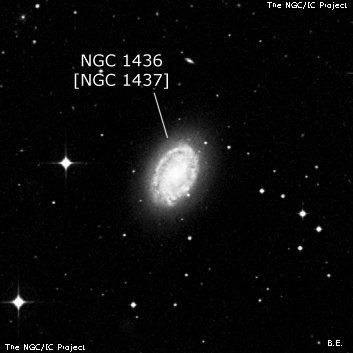NGC/IC Project Restoration Effort
(This is a very very beta version)
NGC1436


Basic Information
Location and Magnitude
Right Ascension: 3:43:37.1
Declination: -35:51:15
Constellation: ERI
Visual Magnitude: 11.7
Historic Information
Discoverer: Herschel J.
Year of discovery: 1835
Discovery aperture: 18.3
Observational
Summary description: globular, vB, pmE, pgbM
Sub-type: SBab
Corwin's Notes
=====
NGC 1436 is almost certainly identical with NGC 1437. JH saw 1436 twice, but
not on the meridian, so did not derive an accurate position for it. The one
position he gives is a rough one from his working list for Dunlop 562. He has
this to say about it: "... I have reason to believe this RA too great and the
NPD also materially in error -- perhaps 126 35 [instead of 126 45] would be
preferable." His single observation of N1437 is from a different sweep with a
secure position. But his diameter estimate of '4"' must be in error as he
calls the galaxy "vL". I would guess that the diameter should read "4'".
This would match Dunlop's estimate of 3.5 arcmin.
Unfortunately, the rough position in the CGH Observations was precessed and
copied into the GC with very little to warn us about its inaccuracy. Only in
the "1?" entries in the columns in GC marked "No. of Obs. used." is there a
hint of the problem. Dreyer did not carry those over, but just copied the
summary description and position directly from GC. So it is that JH's careful
notes in his early work have been lost in the later collections.
In any event, the first suggestion that I've been able to find that N1436 is
N1437 comes from Harold Knox Shaw in Helwan Observatory Bulletin No. 15, 1915
-- but even that is indirect and found under his entry for N1437, not N1436.
For N1436, Knox Shaw says, "Nothing here. [N]1427 answers fairly well to the
description and there are several other similar objects not far away." For
N1437 he writes, "vF, pL, vlE, prob. spir., prob. = Dunlop 562."
I've found one other observation of N1436, that by Schmidt in his Fornax
Cluster paper in AN 2097. There he has it in the penultimate place in his
table of stars and nebulae, and labels it "h 2581". He gives only a position
"3h 35m 11.8s -36 23 49" for 1830 with no description. This is correct only
if the minute of RA is changed to "37". Then, it falls within a few arcsec of
the modern position for N1437.
So things stood until I did SGC in the mid-70s at ROE. There I stumbled
across the missing N1436 again (see below), and scribbled this note in my copy
of Dunlop's paper: "Though Herschel saw Dunlop 562 in two sweeps, he was not
able to get an accurate position for it. His estimated position, however is
nearly that of N1437 for which he did obtain a good place in a third sweep.
The descriptions are similar, so the identity is assumed." This overlooks the
22 arcmin difference in the declinations (ahem), but for the RA, it is not so
bad ... (ahem).
Well, N1436 is a reasonable choice, especially since JH has his note about the
10 arcmin correction to the Dec. Knox Shaw's suggestion of N1427 strikes me
as very unlikely as both the RA and Dec are well off JH's estimated position.
Finally, I first became aware of this puzzle during my years as an amateur
astronomer in the late 1950s. NGC 1436 appeared in the copy of Norton's Star
Atlas that was my introduction to the sky. I was curious about this because
the object did not appear in any other list of deep sky objects that I had at
hand. What was this thing that the NGC claimed was a very bright globular
cluster? Twenty years later, I had my answer. Now, after nearly another 30
years, I'm FINALLY writing it all down. Patience reaps its rewards.
Steve's Notes
=====
NGC 1436
See observing notes for NGC 1437.



